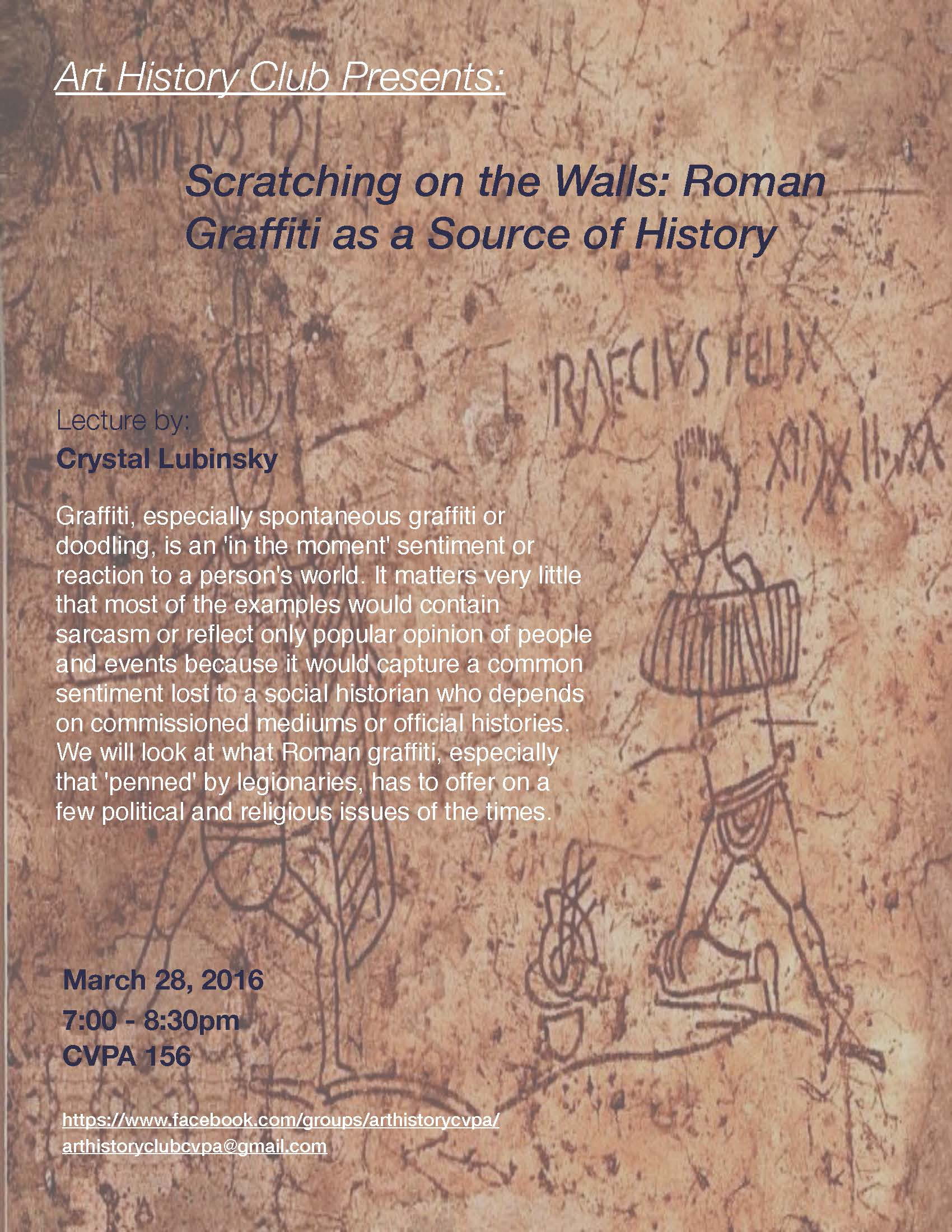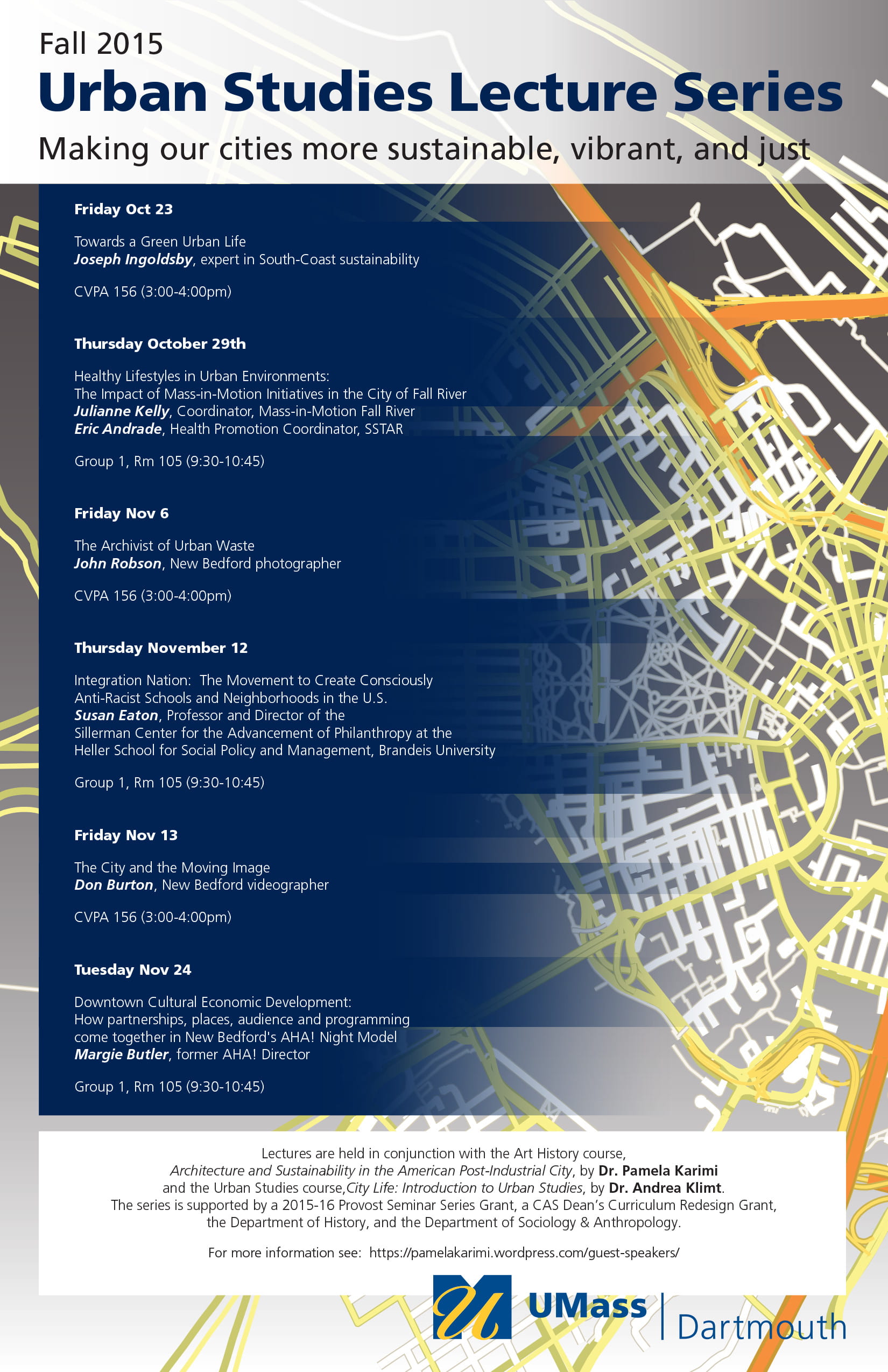Scratching on the Walls: Roman Graffiti as a Source of History
Lecture by Crystal Lubinsky
March 28, 2016 7:00 – 8:30 p.m. CVPA Room 156

Category Archives: guest speakers
Making Sense of the 60’s
Designing for Communities – Art History Department Lecture Series (Fall 2015)
For more details go to https://pamelakarimi.wordpress.com/guest-speakers/ or for more information contact: Dr. Pamela Karimi, Associate Professor of Art History at UMass Dartmouth
Fusing the Past and Present: Thursday, April 2, 2015 (12:45 – 5) at the Claire T. Carney Library, Grand Reading Room
Filmmaker, graphic designer and book illustrator, Hamid Rahmanian, visits Dr. Pamela Karimi Islamic Art Class
 Hamid Rahmanian discusses his latest project Shahnameh (The Book of Kings) for the Digital Age. Video – Part 1/ Video Part 2
Hamid Rahmanian discusses his latest project Shahnameh (The Book of Kings) for the Digital Age. Video – Part 1/ Video Part 2The Way Things Work: Art as Science, Science as Art The Third Annual Undergraduate Student Conference Art History Department, College of Visual and Performing Arts University of Massachusetts, Dartmouth
Undergraduate students at UMass Dartmouth’s Department of Art History
Time and Place of the Conference:
Claire T. Carney Library, Grand Reading Room; University of Massachusetts, Dartmouth
Thursday, April 10th from 1:00 PM to 5:00 PM
Light refreshments will be provided during the conference at no charge.
Keynote Speaker:
Dr. Kirsten Swenson, Assistant Professor of Art History at the University of Massachusetts, Lowell: “Critical Landscapes: Art in the Anthropocene”
 Cutting-edge scientific and technological breakthroughs have indeed augmented artistic initiatives. Sometimes the material qualities and visual dimensions of a technological or a scientific achievement are conceived as art. Otherwise, they have become sources of inspiration for artists. For example, microscopic photography, which is used as a research tool for cancer and neurological disorders, is displayed as art in the Koch Institute Public Galleries at MIT. In her ongoing project Stranger Visions, artist Heather Dewey-Hagborg translates discarded DNA found on city streets into 3-D portraits of the owners. Drexel University scientists and artists are collaborating by using 3-D printers to scan dinosaur bones and fossils. They hope to construct life-size replicas of these ancient animals, providing a more detailed and a much better understanding of how they might have moved and reacted to their environment.
Cutting-edge scientific and technological breakthroughs have indeed augmented artistic initiatives. Sometimes the material qualities and visual dimensions of a technological or a scientific achievement are conceived as art. Otherwise, they have become sources of inspiration for artists. For example, microscopic photography, which is used as a research tool for cancer and neurological disorders, is displayed as art in the Koch Institute Public Galleries at MIT. In her ongoing project Stranger Visions, artist Heather Dewey-Hagborg translates discarded DNA found on city streets into 3-D portraits of the owners. Drexel University scientists and artists are collaborating by using 3-D printers to scan dinosaur bones and fossils. They hope to construct life-size replicas of these ancient animals, providing a more detailed and a much better understanding of how they might have moved and reacted to their environment.
It is with such collaborative efforts and symbiotic relationships between science and art that the separation between art, science and technology is gradually starting to fade away, destroying traditional black-and-white perceptions of art and design as creative pursuits, and science and technology as intellectual queries. Indeed, contrary to popular belief, the arts and the sciences are not diametrically opposed. Rather, one could not exist without the other.
The City at the End of the Reel, Akerman, Perec, Cinematic Counter Memory with guest speaker Matt Tierney
Held from 5 -6 at the UMassD Claire T. Carney Library, Dartmouth MA room 314.
Part of the Art History Lecture Series organized by Dr. Pamela Karimi and part of her Reinventing the Post-Industrial City (Architecture, Preservation and Sustainability) An Open Undergraduate Art History Course
http://pamelakarimi.wordpress.com
http://pamelakarimi.files.wordpress.com/2013/08/arh_fall_lecture0-1.jpg
Art in Public Green Spaces, guest speaker, Stacy Latt Savage
Held at The Jewish Memorial at Frederick Law Olmsted’s Buttonwood Park on November 20, 2013 from 3 -4 p.m. Public Welcome
Part of the Art History Lecture Series organized by Dr. Pamela Karimi and part of her Reinventing the Post-Industrial City (Architecture, Preservation and Sustainability) An Open Undergraduate Art History Course
http://pamelakarimi.wordpress.com
http://pamelakarimi.files.wordpress.com/2013/08/arh_fall_lecture0-1.jpg
Saving the Past: An Afternoon at WHALE
Held November 8, 2013 at Waterfront Historic Area LeaguE
128 Union Street, New Bedford, MA from 3-4 pm. Public Welcome
Part of the Art History Lecture Series organized by Dr. Pamela Karimi and part of her Reinventing the Post-Industrial City (Architecture, Preservation and Sustainability) An Open Undergraduate Art History Course
http://pamelakarimi.wordpress.com
http://pamelakarimi.files.wordpress.com/2013/08/arh_fall_lecture0-1.jpg




